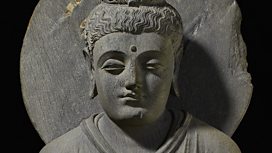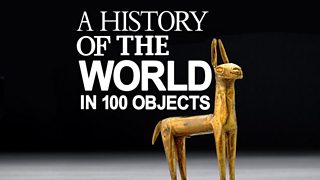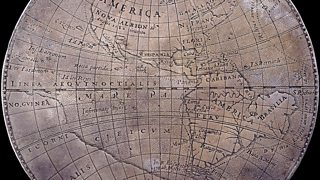Korean roof tile
Korea: source of modern-day electronic components. Neil MacGregor delves into the history of a an artefact from the region.
Last on
![]()
Discover more programmes from A History of the World in 100 Objects about religion
About this object
Location: Korea
Culture: East Asian
Period: 8th century AD
Material: Ceramic
听
The face on this roof tile glares at the viewer. It was intended to scare away evil spirits from a building in the magnificent ancient capital city of Kyongju. Similar tiles were used earlier in China, but once introduced into the Korean peninsula, they reached a new height in popularity and artistry. This face most closely resembles that of a dragon, animals associated with water and hence appropriate as guardians to place on a wooden building always in danger of fire.
What was Korea's grandest city in ancient times?
This tile is from Kyongju, the capital of the Unified Silla dynasty of Korea. The city was famous for its wide streets laid out in a grid. All the houses, palaces and Buddhist temples had tiled roofs, a sign of wealth and sophistication. Decorated roof tiles started to become widespread around AD 688, when the small Korean kingdom of Silla, with help from China, conquered two other Korean kingdoms. This ushered in an age of prosperity and cultural unity in the Korean peninsula.
Did you know?
- Today Koreans call the Silla Kingdom the 'Millennium Kingdom' because it lasted from 95 BC to AD 935.
Keeping up with the Kims
By Jane Portal, Matsutaro Shoriki Chair, Art of Asia, Oceania and Africa, Museum of Fine Arts Boston
听
Houses covered in roof tiles in the city of Kyongju in the eighth and ninth centuries would have been of higher status than those with thatched roofs.
Since the Silla dynasty (under the royal Kim family) had managed to unify the majority of the Korean peninsula with the help of Tang China, there was also no doubt a degree of emulation of China going on: Kyongju grew in size and splendour after it became the capital of the Unified Silla state rather than just the smaller Silla kingdom. Kyongju鈥檚 street grid layout was based on that of the Tang capital Chang-an, the biggest and most cosmopolitan city in the world in the eighth century, at the eastern end of the Silk Road. And there was a huge surge of interest in building projects in Kyongju at this time, with the construction of aristocratic mansions, garden villas and Buddhist temples, all adorned with tiled roofs.
All the aristocrats from the defeated areas of Korea were brought to Kyongju and no doubt wanted to create houses and estates in which they could preserve the lifestyle to which they were accustomed.
But why a monster mask? It is probably the case that this monster mask roof tile was also copying similar tiles from China, as these are known to exist.
The monster mask derived from the ancient Chinese taotie mask which appeared on ritual bronzes. But by the time it appeared on roof tiles it had transformed itself into a protective guardian, placed at the ends of the long ridge of the roof in order to scare off evil spirits. Placed at the highest and most prominent place on the roof, it could be seen for miles around and would stand out as a conspicuous sign of the wealth and high class of the owner of the building, as well as protecting the owners from harm.
So this moulded earthenware roof tile was functional as well as decorative, and a status symbol as well as good-looking: testimony to a highly developed level of Silla craftsmanship and a thriving economy in a capital city at the height of its prosperity.
Transcript
Broadcasts
- Thu 10 Jun 2010 09:45麻豆官网首页入口 Radio 4 FM
- Thu 10 Jun 2010 19:45麻豆官网首页入口 Radio 4
- Fri 11 Jun 2010 00:30麻豆官网首页入口 Radio 4
- Mon 31 Dec 2012 15:45麻豆官网首页入口 Radio 4 Extra
- Thu 18 Mar 2021 13:45麻豆官网首页入口 Radio 4
Featured in...
![]()
Religion—A History of the World in 100 Objects
A History of the World in 100 Objects - objects related to religion.
![]()
Chasing New Year—Chasing New Year
As the clock chimes midnight across the world, 麻豆官网首页入口 Radio 4 Extra raids the 麻豆官网首页入口 archives.
Podcast
-
![]()
A History of the World in 100 Objects
Director of the British Museum, Neil MacGregor, retells humanity's history through objects






